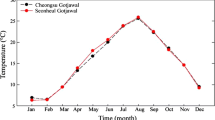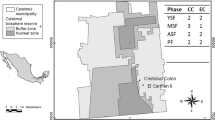Abstract
Evaluation of litterfall production is important for understanding nutrient cycling, forest growth, successional pathways, and interactions with environmental variables in forest ecosystems. Litterfall was intensively studied during the period of 1982–2001 in two subtropical monsoon vegetation gradients in the Dinghushan Biosphere Reserve, Guangdong Province, China. The two gradients include: (1) a successional gradient composed of pine forest (PF), mixed pine and broadleaved forest (MF) and monsoon evergreen broadleaved forest (BF), and (2) an altitudinal gradient composed of Baiyunci ravine rain forest (BRF), Qingyunci ravine rain forest (QRF), BF and mountainous evergreen broadleaved forest (MMF). Mean annual litterfall production was 356, 861 and 849 g m−2 for PF, MF and BF of the successional gradient, and 1016, 1061, 849 and 489 g m−2 for BRF, QRF, BF and MMF of the altitudinal gradient, respectively. As expected, mean annual litterfall of the pioneer forest PF was the lowest, but rapidly increased over the observation period while those in other forests were relatively stable, confirming that forest litterfall production is closely related to successional stages and growth patterns. Leaf proportions of total litterfall in PF, MF, BF, BRF, QRF and MMF were 76.4%, 68.4%, 56.8%, 55.7%, 57.6% and 69.2%, respectively, which were consistent with the results from studies in other evergreen broadleaved forests. Our analysis on litterfall monthly distributions indicated that litterfall production was much higher during the period of April to September compared to other months for all studied forest types. Although there were significant impacts of some climate variables (maximum and effective temperatures) on litterfall production in some of the studied forests, the mechanisms of how climate factors (temperature and rainfall) interactively affect litterfall await further study.
Similar content being viewed by others
References
Albrektson A (1988) Needle litterfall in stands of Pinus sylvestris L. in relation to site quality, stand age and latitude in Sweden. Scand J For Res 3:333–342
Bray JR, Gorham E (1964) Litter production in forests of the world. Adv Ecol Res 2:101–157
Bringmark L (1977) A bioelement budget of an old Scots Pine forest in central Sweden. Silva Fennica 11:201–209
Cárcamo HA, Abe TA, Prescott CE, Chanway CP (2000). Influence of millipedes on litter decomposition, N mineralization, and microbial communities in a coastal forest in British Columbia, Canada. Can J For Res 30:817–826
Chandler RF (1943) Amount and mineral nutrient content of freshly fallen needle litter of some northeastern conifers. Proc Soil Sci Soc Am 8:409–411
Chen ZH, Zhang HT, Wang BS (1992) Studies on biomass and production of the lower subtropical evergreen broad-leaved forest in Heishiding natural reserve (VII): litterfall, litter standing crop and litter decomposition rate. Bot J South China 1(1):24–31 (Chinese with English abstract)
Draper NR, Smith H (1998) Applied regression analysis, 3rd edn. Wiley Series in Probability and Statistics, John Wiley & Sons, Inc
Edmonds RL, Agee JK, Gara RI (2000) Forest Health and protection. McGraw-Hill Series in Forestry
Finer L (1996) Variation in the amount and quality of litterfall in a Pinus sylvestris L. stand growing on a bog. Forest Ecol Manag 80:1–11
Florence RG, Lamb D (1975) Ecosystem processes and the management of radiata pine forests on sand dunes in South Australia. In: Proceedings of the Ecological Society of Australia. Managing Terrestrial Ecosystems 9:34–48
Gordon AM, Chourmouzis C, Gordon AG (2000) Nutrient inputs in litterfall and rainwater fluxes in 27-year old red, black and white spruce plantations in Central Ontario, Canada. Forest Ecol Manag 138:65–78
Haase R (1999) Litterfall and nutrient return in seasonally flooded and non-flooded forest of the Pantanal, Mato Grosso, Brazil. Forest Ecol Manag 117:129–147
Hart SC, Firestone MK, Paul EA (1992) Decomposition and nutrient dynamics of ponderosa pine needles in a Mediterranean-type climate. Can J For Res 22:306–314
Hosking G (2003) Rata litterfall and canopy condition, Whirinaki Forest Park, New Zealand. Department of Conservation Science Internal Series 103, Wellington, New Zealand
Huebschmann MM, Lynch TB, Wittwer RF (1999) Needle litterfall prediction models for even-aged natural shortleaf pine (Pinus echinata Mill) stands. Forest Ecol Manag 117:179–186
Jassby JA, Powell TM (1990) Detecting changes in ecological time series. Ecology 71:2044–2050
Kavvadias VA, Alifragis D, Tsiontsis A, Brofas G, Stamatelos G (2001) Litterfall, litter accumulation and litter decomposition rates in four forest ecosystems in northern Greece. Forest Ecol Manag 144:113–127
Kittredge J (1948) Forest influence. The effects of woody vegetation on climate, water, and soil, with applications to the conservation of water and the control of floods and erosion. Mcgraw-Hill, New York
Kozlowski TT, Kramer PJ, Pallardy SG (1990) The physiological ecology of woody plants. Academic Press, New York
Liu S, Riekerk H, Gholz HL (1997) Leaf litterfall, leaf area index, and radiation transmittance in cypress wetlands and slash pine plantations in north-central Florida. Wetlands Ecol Manag 4:257–271
Liu JX, Chu GW, Yu QF, Zhang DQ, Zhou GY (2002) The responses of soil chemical properties in different forest types along an altitudinal gradient at the Ding-Hu-Shan. Trop Subtrop For Ecosyst 9:125–131. (Chinese with English abstract)
Lu JP, Liu QH (1988) Litter-fall in tropical forest at Jianfengling mountains, Hainan island. Acta Phytoecologica et Geobotanica Sinica 12:104–112. (Chinese with English abstract)
Pedersen LB, Hansen JB (1999) A comparison of litterfall and element fluxes in even aged Norway spruce, sitka spruce and beech stands in Denmark. Forest Ecol Manag 114:55–70
Peng SL, Zhang ZP (1995) Biomass, productivity and energy use efficiency of climax vegetation on Dinghu mountains, Guangdong, China. Sci China (Ser B) 38:67–73
Prescott CE, Blevins LL, Staley CL (2000) Effects of clearcutting on decomposition rates of litter and humus in forests of British Columbia. Can J For Res 30:1751–1757
Prescott CE, Hope GD, Blevins LL (2004) Effects of gap size on litter decomposition and soil nitrate concentrations in a high-elevation spruce-fir forest. Can J For Res 33:2210–2220
Stevens PA, Hornung M, Hughes S (1989) Solute concentrations, and major nutrient cycles in a mature Sitka spruce plantation in Beddgelert Forest North Wales. Forest Ecol Manag 27:1–20
Sundarapandian SM, Swamy PS (1999) Litter production and leaf-litter decomposition of selected tree species in tropical forests at Kodayar in the western Ghats, India. Forest Ecol Manag 123:231–244
Trofymow JA, Moore TR, Titus B, Prescott C, Morrison I, Siltanen M, Smith S, Fyles J, Wein R, Camiré C, Duschene L, Kozak L, Kranabetter M, Visser S (2002) Rates of litter decomposition over 6 years in Canadian forests: influence of litter quality and climate. Can J For Res 32:789–804
Tu MZ, Yao WH, Weng H, Li ZA (1993) Characteristics of litter in evergreen broadleaved forest of the Dinghu mountain. Acta Pedologica Sinica 30:34–42(Chinese with English abstract)
Viro PJ (1955) Investigations on forest litter. Commun Inst For Finl 45–65
Wang ZH, He DQ, Song SD, Chen SP, Chen DR, Tu MZ (1982) The vegetation of the Ding-Hu-Shan Biosphere Reserve. Trop Subtrop For Ecosyst 1:77–141. (Chinese with English abstract)
Waring RH, Schlesinger WH (1985) Forest ecosystems: concepts and management. Academic Press Harcourt Brace Jovanovich, Orlando FL
Wei X, Davidson GW (1998) Impacts of large scale timber harvesting on the hydrology of the Bowron river watershed. In: Younes Alila (ed) Proceedings of the CWRA 51th annual conference: mountain to sea: human interaction with the hydrologic cycle. Canadian Water Resource Association, Victoria, British Columbia
Weng H, Li ZA, Tu MZ, Yao WH (1993) The production and nutrient contents of litter in forests of Ding Hu Shan mountain. Acta Phytoecologica et Geobotanica Sinica 17:299–304 (Chinese with English abstract)
Xiao X, Melillo J, Kicklighter D, McGuire A, Prinn RG, Wang C, Stone PH, Sokolov A (1998) Transient climate change and net ecosystem production of the terrestrial biosphere. Global Biogeochem Cycles 12:345–360
Yi WM, Ding MM, Zhang ZP, Liao LY, Huang ZL (1994) Litter mass and its nitrogen dynamics of Cryptocarya concinna community in the Dinghushan biosphere reserve. Acta Phytoecologica Sinica 18:228–235. (Chinese with English abstract)
Zhang ZP, Ding MM (1996) Biomass and efficiency of radiation utilization in monsoon evergreen broadleaved forest in Dinghushan biosphere reserve. Acta Ecologica Sinica 16:525–534 (Chinese with English abstract)
Zimmermann S, Braun S, Conedera M, Blaser P (2002) Macronutrient inputs by litterfall as opposed to atmospheric deposition into two contrasting chestnut forest stands in southern Switzerland. Forest Ecol Manag 161:289–302
Acknowledgements
We thank Mr. Youchang Zhang, Mr. Dingsheng Mo and many others for the long-term field data collection and analysis. Funding for this long-term study was provided by several research projects, including CERN Funds, Innovation Funds from the Chinese Academy of Sciences (KSCX2-SW-120) and NSFC (30470306). Dr. Paramjit Gill from the Mathematics and Statistics Department, University of British Columbia Okanagan provided valuable advice on statistical analysis. Thanks are also given to two anonymous reviewers who have provided constructive comments on the paper.
Author information
Authors and Affiliations
Corresponding author
Rights and permissions
About this article
Cite this article
Zhou, G., Guan, L., Wei, X. et al. Litterfall Production Along Successional and Altitudinal Gradients of Subtropical Monsoon Evergreen Broadleaved Forests in Guangdong, China. Plant Ecol 188, 77–89 (2007). https://doi.org/10.1007/s11258-006-9149-9
Received:
Accepted:
Published:
Issue Date:
DOI: https://doi.org/10.1007/s11258-006-9149-9




